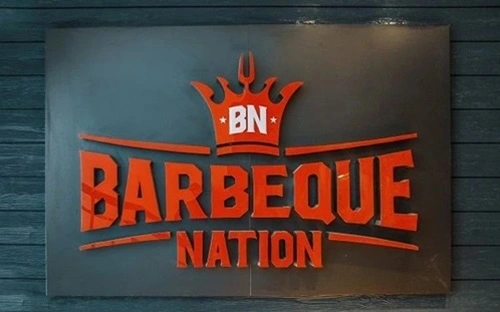Barbeque Nation, one of India’s most popular casual dining restaurant chains, has revolutionized the dining experience with its innovative live grill concept. Launched in 2006 by Sayaji Hotels Ltd., Barbeque Nation has grown into a household name, known for its unique business model, customer-centric approach, and diverse food offerings. This article delves into the business model of Barbeque Nation, analyzing how the company earns money and sustains its operations in a highly competitive market.
The Core Business Model

Barbeque Nation operates on a dine-in restaurant model, offering customers a unique dining experience that combines self-grilling at their tables with a buffet of unlimited food options. The key elements of their business model include:
- Live Grill Concept: Each table is fitted with a live grill where customers can barbecue pre-marinated vegetarian and non-vegetarian skewers. This interactive dining experience differentiates Barbeque Nation from conventional buffet restaurants.
- Buffet-Style Dining: The restaurant provides an all-you-can-eat buffet with a wide variety of starters, main courses, and desserts, catering to diverse culinary preferences.
- Fixed Pricing: Barbeque Nation charges customers a fixed price per head, which varies based on factors such as the time of day (lunch or dinner) and whether it is a weekday or weekend. This pricing strategy ensures transparency and predictable revenue.
- Focus on Customer Engagement: The restaurant emphasizes creating memorable experiences through live entertainment, such as karaoke nights, birthdays, and anniversaries celebrations, fostering customer loyalty.
Revenue Streams
Barbeque Nation generates revenue through multiple channels:
a) In-Restaurant Dining
The primary source of income for Barbeque Nation is its in-restaurant dining services. Customers pay a fixed fee for an unlimited buffet experience. The company leverages its pricing strategy to attract different customer segments:
- Lunch vs. Dinner Pricing: Dinner services are typically priced higher due to increased demand.
- Weekday vs. Weekend Pricing: Weekend rates are higher, capitalizing on increased footfall during leisure days.
b) Takeaway and Delivery
In response to changing customer preferences, Barbeque Nation has diversified its revenue streams by introducing takeaway and delivery services. Through its app and third-party platforms like Swiggy and Zomato, the company offers pre-packed meals and DIY barbecue kits. This initiative has been instrumental in driving revenue during the pandemic and catering to customers who prefer dining at home.
c) Banquet Services
Several Barbeque Nation outlets have banquet spaces for hosting events like birthdays, anniversaries, and corporate gatherings. These services contribute to incremental revenue while enhancing customer engagement.
d) Gift Cards and Memberships
Barbeque Nation also offers gift cards and membership programs like “Smiles Membership.” These programs provide benefits such as discounts, priority reservations, and exclusive offers, encouraging repeat visits and ensuring a steady income stream.
e) Corporate Partnerships
The brand collaborates with corporate clients to host team lunches, events, and reward programs. These partnerships are a lucrative revenue stream, as corporate bookings often involve bulk orders and premium pricing.
Key Cost Components
To understand how Barbeque Nation earns profit, it’s crucial to analyze its cost structure. The major expenses include:
a) Food and Beverage Costs
As a buffet restaurant, food costs constitute a significant portion of expenses. The company sources ingredients in bulk to leverage economies of scale and reduce costs.
b) Real Estate
With over 200 outlets across India and international markets, rental and real estate expenses are substantial. Barbeque Nation typically operates in prime locations to attract high footfall, which translates into higher rentals.
c) Staff Costs
The brand employs a large workforce, including chefs, waitstaff, and management personnel. Staff training and retention are critical to maintaining service quality.
d) Marketing and Promotions
Barbeque Nation invests heavily in marketing through digital campaigns, social media, and partnerships with food delivery platforms to stay relevant and attract new customers.
e) Operational Overheads
Utility costs, maintenance, and technology investments for improving customer experience, such as digital menu systems and loyalty apps, are also significant expenditures.
Key Strategies for Revenue Growth
To stay ahead of the competition and enhance profitability, Barbeque Nation employs the following strategies:
a) Expanding Geographic Reach
Barbeque Nation has been actively expanding its footprint in Tier 2 and Tier 3 cities in India while also entering international markets like the UAE. This geographic diversification increases market penetration and revenue.
b) Enhancing Menu Offerings
The brand regularly updates its menu to include seasonal and regional delicacies. This not only attracts new customers but also ensures repeat visits from existing patrons.
c) Leveraging Technology
Barbeque Nation has adopted technology to streamline operations and improve customer engagement. Its mobile app allows customers to make reservations, order delivery, and access exclusive offers, enhancing convenience and loyalty.
d) Focusing on Customer Experience
The brand’s emphasis on creating memorable dining experiences through live entertainment and personalized service fosters strong customer relationships, resulting in higher retention rates.
e) Sustainability Initiatives
Barbeque Nation is exploring sustainable practices, such as reducing food waste and using eco-friendly materials, to align with evolving consumer values and reduce costs.
Challenges and Competition
While Barbeque Nation has a robust business model, it faces challenges such as:
- Rising Operational Costs: Increasing food, labor, and rental costs can pressure profit margins.
- Intense Competition: The restaurant industry is highly competitive, with players like Absolute Barbecue, Sigree, and other casual dining chains vying for market share.
- Changing Consumer Preferences: Post-pandemic, there is a growing preference for home dining, requiring the brand to balance dine-in and delivery services effectively.
Financial Performance
Barbeque Nation has shown resilience and growth despite challenges like the COVID-19 pandemic. According to its financial reports, the company has rebounded strongly, driven by the recovery of dine-in services and the success of its delivery business. Its IPO in 2021 further strengthened its financial position, enabling investments in expansion and technology.
Conclusion
Barbeque Nation’s success lies in its ability to offer a differentiated dining experience while continuously adapting to market trends. By focusing on customer engagement, menu innovation, and geographic expansion, the brand has built a sustainable business model. As it navigates challenges and explores new opportunities, Barbeque Nation is well-positioned to maintain its leadership in the casual dining segment and continue delighting food lovers across India and beyond.

